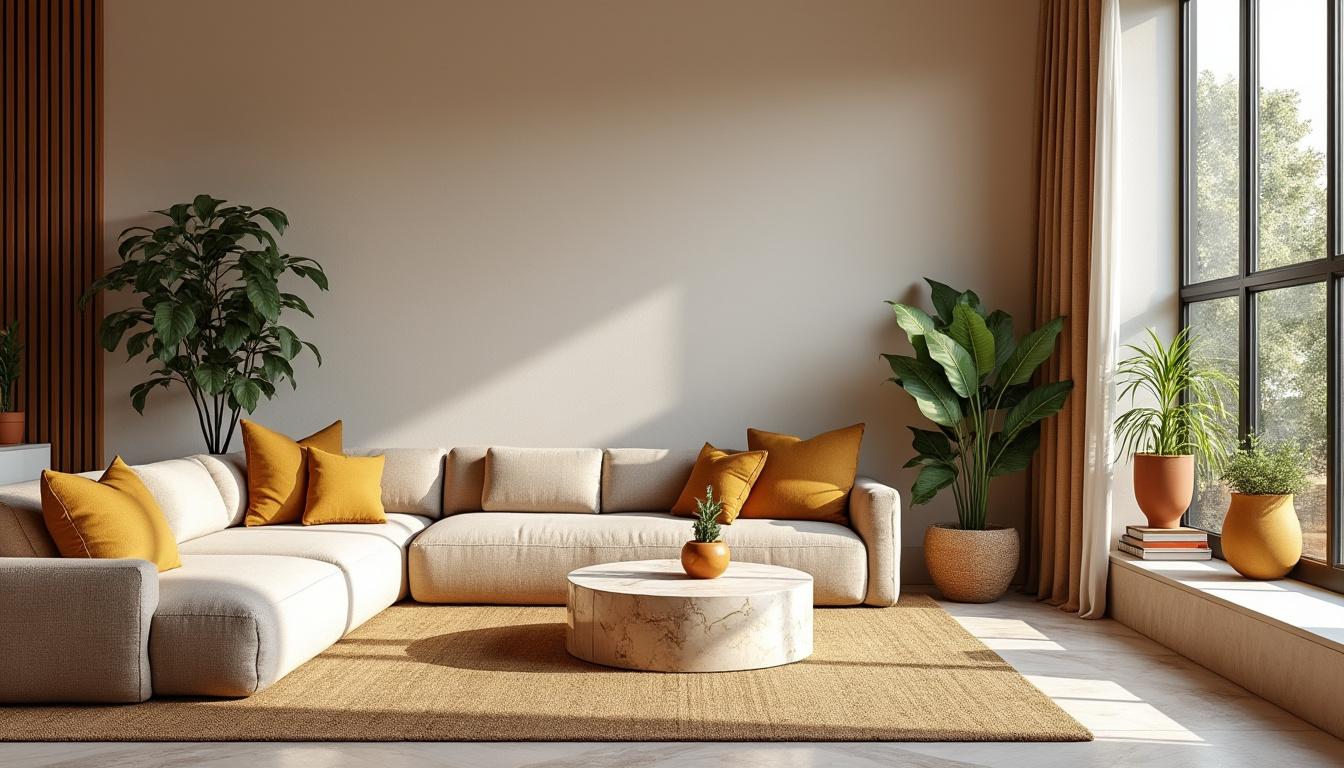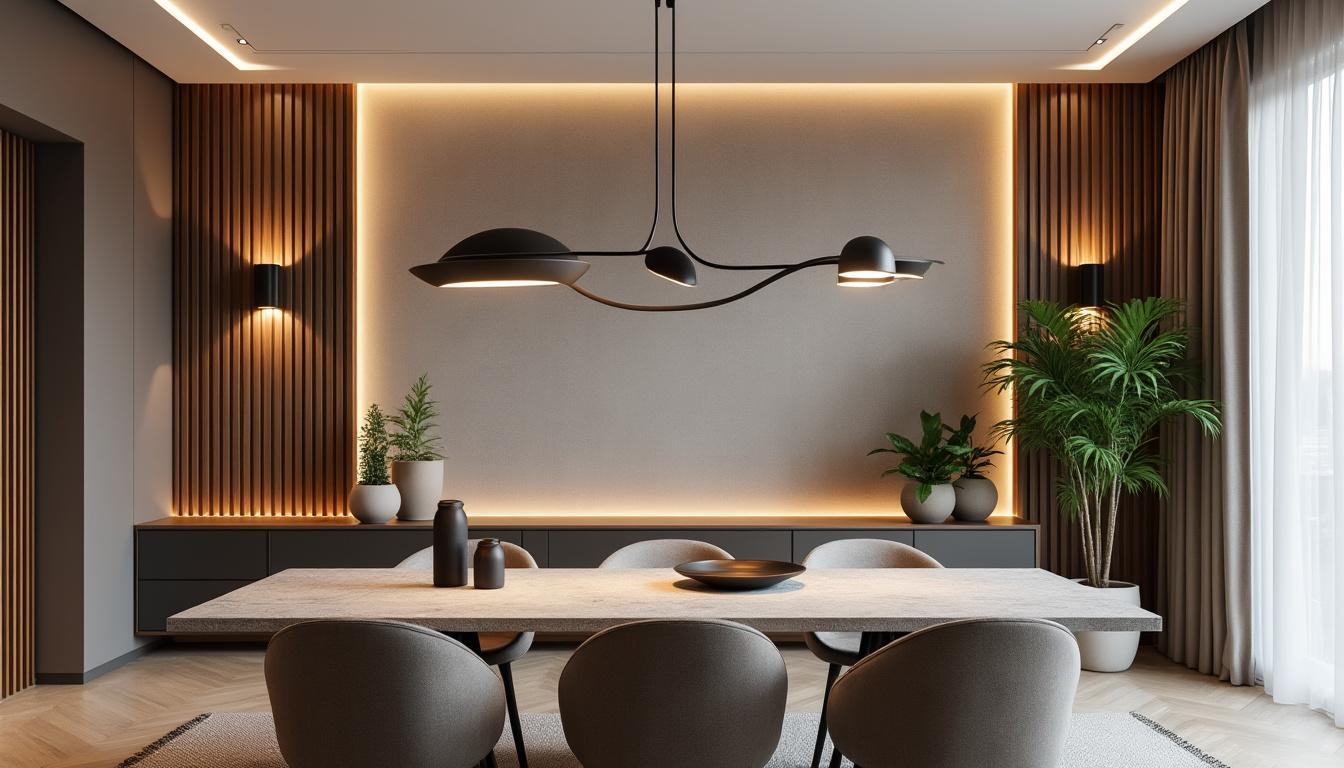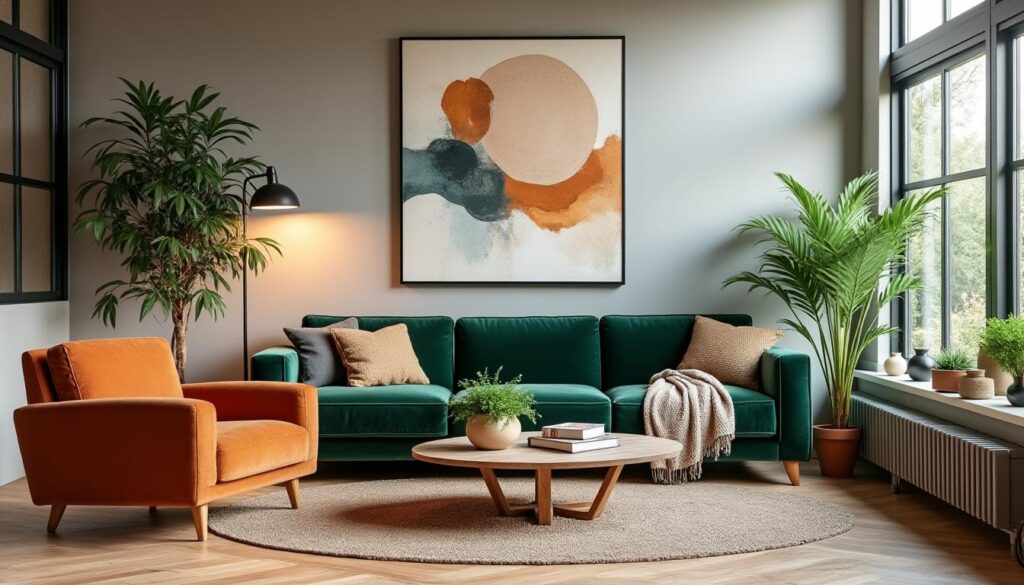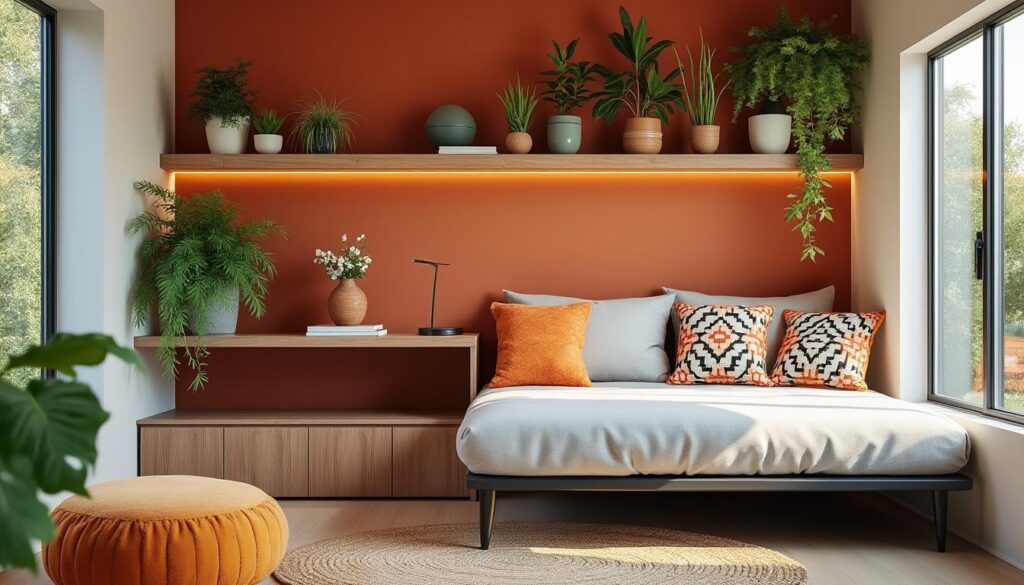Modern environments in 2026 combine comfort, functionality, and personal expression with a focus on natural materials, discreet technology, and well-being. The ideas below show how to transform your home without excess, with smart and sustainable choices.
Short on time? Here’s the essence:
| ✅ Priority | Practical Tip | Benefit | Emoji |
|---|---|---|---|
| Strategic Colors | Neutral base + layered brown and warm color accents | Welcoming and timeless environment | 🎨 |
| Bringing Nature Indoors | Organic minimalism, biodynamic, and natural light | Well-being and better air quality | 🌿 |
| Layered Light | Sculptural lighting + indirect + dimmable scenes | Versatile and elegant atmospheres | 💡 |
| Personality | Mix vintage, author design, and chrome metals | Identity and sophistication | 🪑 |
| Texture and Shape | Natural stone, tactile fabrics, curves, and organic carpets | Sensorial comfort and fluidity | 🧶 |
2026 Color Palettes: Brown as the Protagonist and Color Points to Transform Modern Environments
The right color changes the perception of space in seconds. In 2026, shades of brown return strongly, conveying stability, sophistication, and connection to nature. Varying between caramel, tobacco, chocolate, and terracotta creates depth without heaviness, especially when combined with light bases and natural textures.
A room with gray beige walls and a caramel sofa immediately gains warmth. If you prefer discretion, keep the brown in the furniture – sideboards, shelves, chairs – and maintain the walls in off-white. To energize, include warm color accents like mustard, terracotta, and coral in cushions, throws, vases, and art. This creates a vibrant contrast with a clean and contemporary reading.
How to Combine Brown and Warm Colors Without Overwhelming
The brown works well with materials like linen, light wood, straw, and stone, reinforcing the organic effect. Warm colors require moderation: two or three accents are enough to enliven the neutral base. In kitchens, walnut cabinet doors and brushed steel handles come alive with mustard benches; in the bedroom, a wooden headboard shaded by bronze wall lamps creates an inviting atmosphere.
- 🎯 60/30/10 Rule: 60% neutral base, 30% brown, 10% vibrant color.
- 🌰 Layered Browns: caramel in upholstery, walnut in furniture, terracotta in vases.
- 🖼️ Art as a Color Point: a painting with burnt red and vivid pink lifts the ensemble.
- 🪵 Natural Materials: linen, jute, and light wood soften dark tones.
- ♻️ Low VOC Paints: reduce odors and improve air quality.
Quick case study: in an urban T2, sand walls and a chocolate sofa seemed dark. By replacing the coffee table with a light travertine one, including terracotta cushions, and a graphic poster with mustard yellow, the space gained light and movement without any heavy renovations.
| Brown Shade | Best Use | Effect on Space | Quick Tip | Emoji |
|---|---|---|---|---|
| Caramel | Upholstered furniture and chairs | Welcoming without darkening | Combine with raw linen | 🛋️ |
| Chocolate | Accent walls | Depth and elegance | Illuminate with indirect light | 🍫 |
| Terracotta | Vases, throws, ceramics | Warmth and personality | Use as 10% of the scheme | 🧡 |
| Tobacco | Wooden furniture | Sobriety and timelessness | Chrome metals balance | 🪵 |
To avoid mistakes, choose a light base, elect a dominant brown, and apply two warm notes. The result is modern, comfortable, and ready to engage with plants and natural light in the next step.

Organic Minimalism and Biodynamics: Integrating Nature and Well-Being in Modern Decoration in 2026
Minimalism in 2026 is not empty: it is essential with warmth. The organic language abandons rigid angles and favors curves, natural materials, and plants in smart compositions. The goal is to reduce visual excess without sacrificing sensory comfort and daily functionality.
Plants cease to be mere decoration and begin to structure the space: they define axes, frame views, and improve air quality. Natural light and cross ventilation make the environment healthier, with less dependence on artificial lighting during the day. Materials like certified wood, stone, linen, and handmade ceramics enhance the tactile sensation and the connection to the outdoors.
Practical Steps for an Organic and Lively Composition
The process begins by emptying and healing. Fewer pieces, more meaningful ones. Then comes texture, vegetation, and light. The result is a refuge that slows down the mind and keeps the home functional for telework, rest, and socializing.
- 🧭 Define an Axis: align sofa, rug, and table to guide the eye.
- 🌿 Intelligent Biodynamics: a sculptural plant (fiddle leaf, monstera) as a focal point.
- 🌞 Maximize Light: curtains in light linen and well-positioned mirrors.
- 🪑 Curves in Furniture: oval tables and rounded armchairs soften the flow.
- 🧴 Healthy Finishes: low VOC paints and natural oils on wood.
Applied example: in a glassed-in balcony transformed into a living space, a light wood bench, vases at different heights, and a sisal rug created a microgarden. The space began to function as a reading area in the morning and a meditation spot in the evening, without heavy renovations.
| Plant | Light/Maintenance | Benefit | Recommended Use | Emoji |
|---|---|---|---|---|
| Zamioculca | Partial shade, low watering | Resistant and purifying | Hall or office | 🪴 |
| Jiboia | Diffuse light, moderate watering | Graceful droop and easy to care for | Shelves and niches | 🌱 |
| Ficus lyrata | Intense indirect light | Scultural focal point | Living and large rooms | 🌿 |
| Aromatic Herbs | Partial direct light | Functionality in the kitchen | Vertical garden | 🌿🍃 |
If the goal is to speed up results, invest in a trio: natural rug, a leading plant, and a table lamp with a linen shade. The base for layered lighting will be ready.
Sculptural Lighting and Light Layers: The Ultimate Trick to Transform Spaces in 2026
Light is not just a technique; it’s a language. In 2026, lamps take on the role of functional sculptures and the layered composition – ambient, task, and accent – creates scenarios that change with a touch. The effect is immediate: volumes gain depth, textures stand out, and the atmosphere adjusts to mood and use.
Organic pendants, lamps with sculptural bases, and “floating” columns become protagonists, even when turned off. The distribution of light is equally important: indirect light baths on the walls visually expand spaces, dimmable LEDs calibrate the color temperature, and directional spots showcase artworks, shelves, and reliefs.
How to Design Beautiful and Efficient Light
The starting point is the use of the environment. A living room calls for warmth; a kitchen, precision. In both cases, energy efficiency counts: LEDs with a high color rendering index (CRI 90+) and dimmable drivers ensure visual comfort and savings. In homes with solar panels, programming scenes at sunset optimizes the day’s production.
- 💡 Diffuse Ambient Light: ceiling fixtures or tracks with soft light (2700K–3000K) for warmth.
- 🎯 Focused Task Light: spots on countertops (3500K–4000K) for precision without glare.
- ✨ Dramatic Accent Light: wall sconces and LED strips in niches and coves.
- 🎚️ Dimmer Everywhere: a single circuit with a dimmer changes the space’s mood.
- ♻️ Honest Materials: blown glass, handmade ceramics, and brushed metal.
In an open space, a warm LED cove defines the perimeter, pendants over the table create a dining scene, and wall sconces highlight the slatted design. In the home office, an articulated lamp avoids shadows and improves focus. Small decisions change the experience of the space.
| Scene | Color Temperature | Intensity | Objective | Emoji |
|---|---|---|---|---|
| Night Reading | Warm 2700K | 30–40% | Relax without straining the eyes | 📖 |
| Intimate Dinner | 2700K–3000K | 40–60% | Conversation and coziness | 🍷 |
| Focused Work | 3500K–4000K | 80–100% | Concentration and precision | 🧠 |
| Entertaining Friends | 3000K | 60–70% | Highlight textures and art | 🖼️ |
Choosing a striking lamp for each environment creates identity without overstepping the budget. Think of them as “jewels” that also illuminate. The mix with chrome metals and stainless steel, as discussed next, enhances brightness and contemporary reading.

Design Pieces, Vintage, and Chrome Metals: Personality with Future in Decoration 2026
Environments that tell stories combine design furniture with vintage finds and metallic details. In 2026, the conscious mix of eras creates a rich contrast: the chrome tubular chair converses with the family china cabinet; the author sideboard meets the futuristic aesthetic lamp. The result: character without losing lightness.
Recovering and reusing is sustainable and elegant. An old dresser receives a new mineral paint, inherits chrome handles, and shines again. Polished and chrome metals come in as points of light – table feet, shelf structures, frames, and lamps – balancing the organic nature of wood and stone. The shine is controlled, not ostentatious.
How to Mix Eras with Cohesion
The secret lies in curation. Define a palette and repeat materials. If brown is the base, use walnut in the vintage piece and echo the tone in the top of another piece. Chrome should appear in three spots at most, to cadences the reflections. The composition gains rhythm, and nothing seems “out of place.”
- 🧭 Unifying Palette: choose 3-4 shades and repeat them in the pieces.
- 🪞 Point Metals: chrome on legs and lamps for controlled shine.
- 🛠️ Conscious Restoration: preserve original hardware when possible.
- 🧩 Balanced Mix: 1 iconic piece + 2 neutral for the surroundings.
- 📐 Proportion: hollow and tubular items maintain visual lightness.
In a compact living space, two chrome tubular chairs, a glass coffee table, and an antique trunk as a support create an interesting contrast. With an organic rug and plants, the language remains contemporary and welcoming.
| Item | Material/Finish | Aesthetic Function | Usage Tip | Emoji |
|---|---|---|---|---|
| tubular Chair | Chrome/brushed steel | Lightness and futuristic touch | Double by the window | 🪑 |
| Vintage Trunk | Solid wood | History and texture | Use as a side table | 📦 |
| Hollow Shelf | Chrome metal + wood | Amplitude and organization | Divider between living and dining | 🧱 |
| Sculptural Lamp | Blown glass/metal | Focal point | Position outside of the center | 💡 |
To find pieces with soul, local antiques and flea markets are allies. When buying, check structure, hardware, and the possibility of sustainable adjustments. A well-done curation transforms the space and extends the life cycle of materials.
Textures, Natural Stone, and Curves: Tactile Comfort that Changes the Perception of the Environment in 2026
If the eye chooses the house, the touch makes it stay. In 2026, the spotlight is on accentuated textures and curved forms, which make environments more human and serene. Fabrics like bouclé and wool provide warmth; sturdy linen and velvet give density; walls made of burnt cement, slatted wood, and exposed brick create depth.
Natural stone is a safe bet: travertine in tables and panels, marble on countertops, slate on floors. Each piece is unique, with veins and porosities that tell stories. Instead of “coldness,” stone converses with wood and linen, elevating the ensemble. Curves in furniture and arches soften paths and eliminate sharp corners, improving circulation and the feeling of well-being.
How to Compose a Tactile and Fluid Scenario
Think in layers: comfortable flooring, organic rug, soft upholstery, mineral surfaces, and discreet metallic points. The freely-shaped rug “draws” the living area; the curved table avoids collisions; the textured wall provides a backdrop for scenic lighting. The ensemble is harmonious and practical for real life.
- 🧶 Mix Textures: bouclé + stone + wood for a balanced contrast.
- 🪨 Natural Surfaces: light travertine to illuminate and last.
- 🌀 Strategic Curves: oval tables and arches in passageways.
- 🗺️ Organic Rug: free contour to break the rigidity of the layout.
- 🧼 Maintenance: sealer on stone and regular vacuuming on bouclé.
In a master bedroom, an upholstered headboard in bouclé, a rug with an irregular shape, and curved side tables create a cocoon feel. An indirect light sconce enhances the fabric’s relief and allows for comfortable reading. The same reasoning applies to halls and corridors, where an arch and a wooden bench change the perception of a narrow space.
| Material/Shape | Where to Use | Advantage | Care | Emoji |
|---|---|---|---|---|
| Bouclé | Sofas and armchairs | Comfort and rich texture | Vacuum and brush the threads | 🧵 |
| Travertine | Tables and panels | Timeless luxury | Seal and avoid acids | 🪨 |
| Burnt Cement | Accent walls | Depth and neutrality | Stain-resistant sealer | 🏗️ |
| Curves in Furniture | Oval tables/sofas | Flow and safety | Check proportion | 🌀 |
As an immediate action, choose a room and introduce three elements: an organic rug, a sculptural lamp, and a leading plant. In a few hours, the environment will look new, more human, and aligned with trends of 2026. For sustainable ideas and practical guides, consult the curation published at Ecopassivehouses.pt.
{“@context”:”https://schema.org”,”@type”:”FAQPage”,”mainEntity”:[{“@type”:”Question”,”name”:”How to use brown without darkening the environment?”,”acceptedAnswer”:{“@type”:”Answer”,”text”:”Opt for a clear base (off-white, sand beige), introduce brown in layers (caramel in upholstery, wood in furniture) and add warm color points (mustard/terracotta) in up to 10% of the set. Warm indirect lighting (2700K–3000K) maintains warmth without heaviness.”}},{“@type”:”Question”,”name”:”Which plants are easier for interiors?”,”acceptedAnswer”:{“@type”:”Answer”,”text”:”Zamioculca and jiboia are resistant and low maintenance; for emphasis, Ficus lyrata works well as a green sculpture. In kitchens, aromatic herbs in vertical gardens unite function and decoration.”}},{“@type”:”Question”,”name”:”Is smart lighting worth it?”,”acceptedAnswer”:{“@type”:”Answer”,”text”:”Yes, dimmable scenes and LEDs CRI 90+ enhance visual comfort and versatility, as well as reduce consumption. A single sculptural light fixture per environment already alters the reading of the space.”}},{“@type”:”Question”,”name”:”How to mix vintage pieces and chrome metals?”,”acceptedAnswer”:{“@type”:”Answer”,”text”:”Define a unifying palette, repeat materials, and limit chrome to 2–3 points per environment. Restore vintage items with neutral finishes and complement with light tubular structures to maintain amplitude.”}},{“@type”:”Question”,”name”:”Does natural stone require maintenance in everyday life?”,”acceptedAnswer”:{“@type”:”Answer”,”text”:”With the right sealer and gentle cleaning, travertine and marble work very well. Prefer dry areas for large panels and use boards and placemats on countertops to preserve the finish.”}}]}How to use brown without darkening the environment?
Opt for a clear base (off-white, sand beige), introduce brown in layers (caramel in upholstery, wood in furniture) and add warm color points (mustard/terracotta) in up to 10% of the set. Warm indirect lighting (2700K–3000K) maintains warmth without heaviness.
Which plants are easier for interiors?
Zamioculca and jiboia are resistant and low maintenance; for emphasis, Ficus lyrata works well as a green sculpture. In kitchens, aromatic herbs in vertical gardens unite function and decoration.
Is smart lighting worth it?
Yes, dimmable scenes and LEDs CRI 90+ enhance visual comfort and versatility, as well as reduce consumption. A single sculptural light fixture per environment already alters the reading of the space.
How to mix vintage pieces and chrome metals?
Define a unifying palette, repeat materials, and limit chrome to 2–3 points per environment. Restore vintage items with neutral finishes and complement with light tubular structures to maintain amplitude.
Does natural stone require maintenance in everyday life?
With the right sealer and gentle cleaning, travertine and marble work very well. Prefer dry areas for large panels and use boards and placemats on countertops to preserve the finish.


